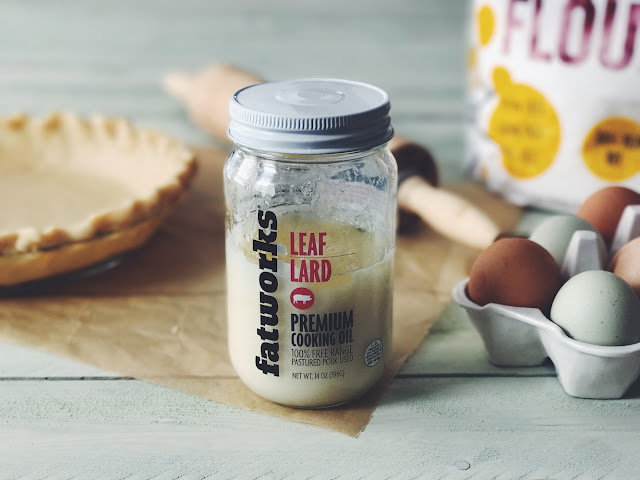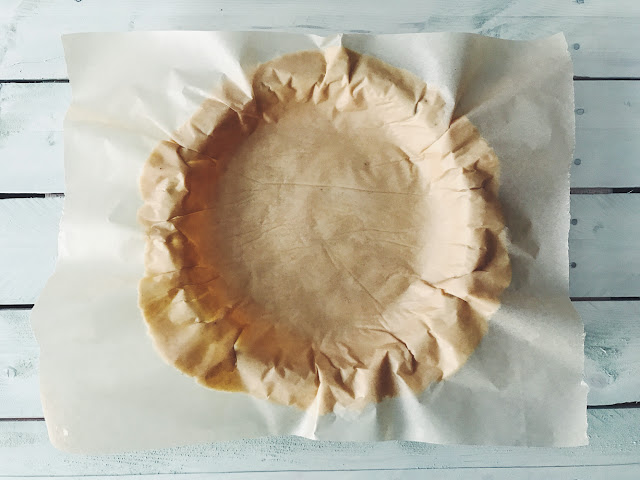Grandma has made a lot of pies in her nearly 90 years of life, and she’s also tinkered with different pie crust recipes. I can remember making pies with her (like this peach pie) and sometimes we used shortening (usually butter flavored Crisco), and sometimes we used lard, and sometimes we used a combination of shortening and lard.
While Grandma’s original crust recipe used all lard, I’ve adjusted my version to use half lard and half shortening for a couple of reasons…. First of all, I’m passionate about using well-sourced ingredients, and pastured leaf lard (a higher quality lard) is a more expensive ingredient than I usually use in my recipes. Secondly, while leaf lard isn’t quite as pork-y in flavor as traditional lard, I still find it tastes better when mixed with a more neutral fat, like palm shortening.
**As with most of my recipes, I’ve only tested this recipe using the grams measurements included. I’ve figured out volume measurements with math, but have not personally tested them. I HIGHLY recommend using a kitchen scale + grams measurements to ensure the most successful end product.**
Lard Cassava Pie Crust (Paleo, Nut-Free, AIP Reintroduction)
adapted from my Grandma Vein’s recipe collection
yields 3 single regular 9-inch crusts or two deep dish crusts (with some leftover scraps)
168 grams (3/4 cup) pastured leaf lard (I use Fatworks)
144 grams (3/4 cup) palm shortening (I use Spectrum Naturals)
384 grams (3 cups) cassava flour (I use Otto’s), plus extra for sprinkling, if needed
60 grams (1/2 c) tapioca starch
30 grams (1/4 c) arrowroot
1 tablespoon maple sugar (or other granulated Paleo sweetener)
1 1/2 teaspoon fine sea salt
1/2 cup cold water
1 tablespoon apple cider vinegar
1 large egg (I use a soy-free pastured farm egg)
- Scale the leaf lard and palm shortening and place into the freezer to chill for at least 20 minutes. I scale both onto individual pieces of plastic wrap, then wrap/flatten them into little packets before freezing.
- While the fats are chilling, scale the cassava flour, tapioca, arrow root, maple sugar, and sea salt into a large bowl. Stir to combine.
- Once the fats are solid, remove them from the freezer and cut them up into small pieces. Add the small pieces to the mixing bowl with the dry ingredients. Use a pastry blender or two forks to work the cold fat into the dry ingredients. Continue mixing until the mixture looks like coarse sand.
- Measure the cold water into a liquid measuring cup. Add the apple cider vinegar and egg to the liquid measuring cup & whisk together using a small whisk or a fork. Add to the fat/flour mixture and mix, using a pastry blender and/or a wooden spoon, until the liquid is evenly distributed and a dough forms. Work as quickly as possible to ensure the fat doesn’t melt. The dough will be quite soft.
- For regular crusts, divide the dough into three equal pieces (approximately 322 grams each). For deep dish crusts, divide the dough into two equal pieces (approximately 483 grams each). Wrap individually in plastic wrap and flatten into a disc. Refrigerate for at least 30 minutes before rolling out. Dough also may be frozen for use later—I usually place individually wrapped dough discs into freezer ziplocks.
- When ready to use, roll the dough out between two pieces of parchment paper. Sprinkle with a little extra cassava flour if the dough sticks to the parchment. Use the parchment paper to help transfer the rolled out dough to a pie pan (I use 9-inch glass Pyrex pie pans). Crimp or trim the edges as desired. Save the scraps for later!
- Bake as directed in a pie recipe (or see my notes below). This dough does not brown like a traditional pie crust, so be careful not to over-bake it in hopes of a golden crust.
Notes:
- I’ve only tested this recipe using the grams measurements included. I’ve figured out volume measurements with math, but have not personally tested them.
- I haven’t tried making this dough in the food processor, but suspect it could be done that way too.
- I do not recommend using regular lard in place of leaf lard, as the pie crust flavor will be *very* pork-y.
- To make this recipe more cost effective, I chose to use half leaf lard and half shortening. I have not tested it using all lard because I ran out of leaf lard…
- I have not tried any flours, other than Otto's cassava flour, tapioca, and arrowroot. If you try this recipe with other flours and it turns out well, please let me know in the comments.
- The egg helps with plasticity of the dough & I have not yet tried an AIP version of this recipe without the egg. If you need an AIP pie crust recipe, I’ve got one in my e-book Holiday Sweet Treats.
- If you live in a very dry climate, you may need a little extra cold water, if the dough doesn’t come together easily. More cold water can be added a tablespoon at a time.
- Any dough scraps can be saved and re-rolled (or frozen and used later).
- Some baking direction for a 9-inch glass Pyrex pan, if your intended pie recipe doesn’t include them. Reduce the baking times for a metal pie pan.
- For a double crust pie (not deep dish), I usually begin baking at 400 F for 15 minutes, then reduce the heat to 350 F for 30 to 40 additional minutes.
- For a single crust pie (not deep dish), I begin baking at 400 F for 15 minutes, then reduce the heat to 350 F for 20 to 30 additional minutes.
- For blind baking (not deep dish), line the pie shell with parchment paper and fill with dry rice or dry beans (note: these act as weights and are NOT eaten); bake for 15 minutes in a 357 F oven, then remove the parchment/rice/beans and bake for an additional 15 to 25 minutes.
- This dough does not brown like a traditional pie crust so it will not be golden when finished. Brush an egg wash on top (straight egg or egg mixed with water) to give it a little extra color and/or shine, if desired.
This post contains affiliate links, meaning Sweet Treats makes a small commission off items purchased
after an Amazon link is clicked with no additional cost to you. Thanks for your support.







